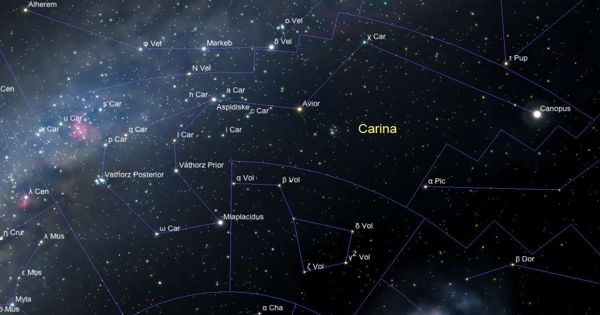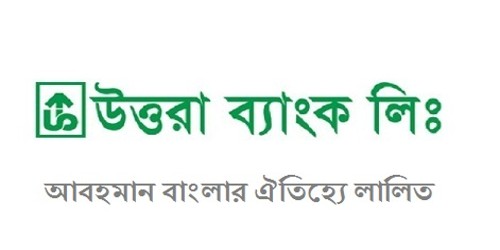This article is about the geographical region of Kashmir:

Political Map: the Kashmir region districts, showing the Pir Panjalrange and the Valley of Kashmir.
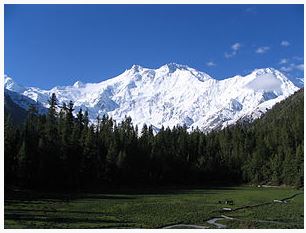
Ninth-highest: Nanga Parbat, a dangerous mountain to climb, is in the Kashmiri region of Gilgit-Baltistan in Pakistan
Kashmir (Balti, Gojri, Poonchi/Chibhali, Dogri: कश्मीर; Kashmiri: कॅशीर, کٔشِیر;Ladakhi: ཀཤམིར; Uyghur: كەشمىر; Shina: کشمیر) is the northwestern region of the Indian subcontinent. Until the mid-19th century, the term Kashmirgeographically denoted only the valley between the Great Himalayas and the Pir Panjal mountain range. Today Kashmir denotes a larger area that includes the Indian-administered state of Jammu and Kashmir (the Kashmir valley, Jammu and Ladakh), the Pakistani-administered Gilgit-Baltistan and the Azad Kashmir provinces, and the Chinese-administered regions ofAksai Chin and Trans-Karakoram Tract.
In the first half of the first millennium, the Kashmir region became an important center of Hinduism and later of Buddhism; later still, in the ninth century, Kashmir Shaivism arose.[1] In 1349, Shah Mir became the firstMuslim ruler of Kashmir and inaugurated the Salatin-i-Kashmir or Swatidynasty.[2] For the next five centuries, Muslim monarchs ruled Kashmir, including the Mughals, who ruled from 1526 until 1751, then the AfghanDurrani Empire that ruled from 1747 until 1820.[2] That year, the Sikhs underRanjit Singh, annexed Kashmir.[2] In 1846, upon the purchase of the region from the British under the Treaty of Amritsar, the Dogras—under Gulab Singh—became the new rulers. Dogra Rule, under the paramountcy (or tutelage) of the British Crown, lasted until 1947, when the former princely state became a disputed territory, now administered by three countries:India, Pakistan, and the People’s Republic of China.
Etymology
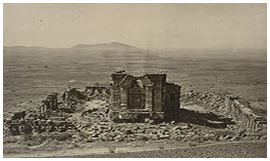
General view of Temple and Enclosure of Marttand or the Sun, near Bhawan. Probable date of temple AD 490-555. Probable date of colonnade AD 693-729. Photograph of the Surya Temple at Martand in Jammu & Kashmir taken by John Burke in 1868.
According to the “Nilmat Puran,” the oldest book on Kashmir, in the Satisar, a former lake in the Kashmir Valley meaning “lake of the Goddess Sati,”[3] lived a demon called Jalodbhava (meaning “born of water”), who tortured and devoured the people, who lived near mountain slopes.[4] Hearing the suffering of the people, Kashyap, an Indian rishi, came to the rescue of the people that lived there.[4] After performing penance for a long time, the saint was blessed, and therefore Lord Vishnu assumed the form of a boar and struck the mountain at Varahamula, boring an opening in it for the water to flow out into the plains below.[5] The lake was drained, the land appeared, and the demon was killed.[4] The saint encouraged people from India to settle in the valley.[4] As a result of the hero’s actions, the people named the valley as “Kashyap-Mar”, meaning abode of Kashyap, and “Kashyap-Pura”, meaning city of Kashyap, in Sanskrit.[4] The name “Kashmir,” in Sanskrit, implies land desiccated from water: “ka” (the water) and shimeera (to desiccate).[4] The ancient Greeks began referring to the region as “Kasperia” and the Chinese pilgrim Hien-Tsangwho visited the valley around 631 AD. called it “KaShi-Mi-Lo”.[4] In modern times the people of Kashmir have shortened the full Sanskrit name into “Kasheer,” which is the colloquial Koshurname of the valley, as noted in Aurel Stein’s introduction to the Rajatarangini metrical chronicle.[4]
The “Rajatarangini,” a history of Kashmir written by Kalhana in the 12th century, concurs with Nilmat Puran, stating that the valley of Kashmir was formerly a lake. This lake was drained by the great rishi or sage, Kashyapa, son of Marichi, son of Brahma, by cutting the gap in the hills at Baramulla (Varaha-mula). Cashmere is a variant spelling of Kashmir, especially within the English language.[6]
According to folk etymology, the name “Kashmir” means “desiccated land” (from the Sanskrit: Ka = water and shimeera = desiccate). In the Rajatarangini, a history of Kashmir written by Kalhana in the mid-12th century, it is stated that the valley of Kashmir was formerly a lake. According to Hindu mythology, the lake was drained by the great rishi or sage, Kashyapa, son of Marichi, son of Brahma, by cutting the gap in the hills at Baramulla (Varaha-mula). When Kashmir had been drained, Kashyapa asked Brahmans to settle there. This is still the local tradition, and in the existing physical condition of the country, we may see some ground for the story which has taken this form. The name of Kashyapa is by history and tradition connected with the draining of the lake, and the chief town or collection of dwellings in the valley was called Kashyapa-pura, which has been identified with Kaspapyros of Hecataeus (apud Stephanus of Byzantium) and Kaspatyros of Herodotus (3.102, 4.44).[1] Kashmir is also believed to be the country meant by Ptolemy’s Kaspeiria.[2]
Cashmere is an archaic spelling of Kashmir, and in some countries it is still spelled this way.
According to legend, Jammu was founded by Raja Jamboolochan in the 14th century BC. During one of his hunting campaigns he reached the Tawi River where he saw a goat and a lion drinking water at the same place. The king was impressed and decided to set up a town after his name, Jamboo. With the passage of time, the name was corrupted and became “Jammu”.
Early history
Buddhism and Hinduism in Kashmir
Hindu temple of Jyeshteswara (Shankaracharya), on the Takht-i-Suleiman Hill, near Srinagar.
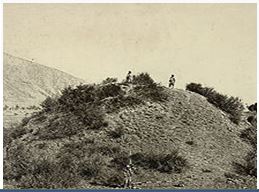
This general view of the unexcavatedBuddhist stupa near Baramulla, with two figures standing on the summit, and another at the base with measuring scales, was taken by John Burke in 1868. The stupa, which was later excavated, dates to 500 AD.
According to the “Nilmat Puran,” which is a mythological text on Kashmir, in the Satisar, a former lake in the Kashmir Valley meaning “lake of the Goddess Sati,”[3] lived a demon called Jalodbhava (meaning “born of water”), who tortured and devoured the people, who lived near mountain slopes.[4] Hearing the suffering of the people, Kashyap, an Indian rishi, came to the rescue of the people that lived there.[4] After performing penance for a long time, the saint was blessed, and therefore Lord Vishnu assumed the form of a boar and struck the mountain at Varahamula, boring an opening in it for the water to flow out into the plains below.[5] The lake was drained, the land appeared, and the demon was killed.[4] The saint encouraged people from India to settle in the valley.[4] As a result of the hero’s actions, the people named the valley as “Kashyap-Mar”, meaning abode of Kashyap, and “Kashyap-Pura”, meaning city of Kashyap, in Sanskrit.[4] The name “Kashmir,” in Sanskrit, implies land desiccated from water: “ka” (the water) and shimeera (to desiccate).[4] The ancient Greeks began referring to the region as “Kasperia” and the Chinese pilgrim Hien-Tsang who visited the valley around 631 AD. called it “KaShi-Mi-Lo”.[4] In modern times the people of Kashmir have shortened the full Sanskrit name into “Kasheer,” which is the colloquial Koshur name of the valley, as noted in Aurel Stein’s introduction to the Rajataranginimetrical chronicle.[4]
The Buddhist Mauryan emperor Ashoka is often credited with having founded the old capital of Kashmir, Shrinagari, now ruins on the outskirts of modern Srinagar. Kashmir was long to be a stronghold of Buddhism.[7]
As a Buddhist seat of learning, the Sarvāstivādan school strongly influenced Kashmir.[8] East andCentral Asian Buddhist monks are recorded as having visited the kingdom. In the late 4th century AD, the famous Kuchanese monk Kumārajīva, born to an Indian noble family, studied Dīrghāgamaand Madhyāgama in Kashmir under Bandhudatta. He later became a prolific translator who helped take Buddhism to China. His mother Jīva is thought to have retired to Kashmir. Vimalākṣa, a Sarvāstivādan Buddhist monk, travelled from Kashmir to Kucha and there instructed Kumārajīva in the Vinayapiṭaka.
Adi Shankara visited the pre-existing Sarvajñapīṭha (Sharada Peeth) in Kashmir in late 8th century or early 9th century AD. The Madhaviya Shankaravijayam states this temple had four doors for scholars from the four cardinal directions. The southern door (representing South India) had never been opened, indicating that no scholar from South India had entered the Sarvajna Pitha. Adi Shankara opened the southern door by defeating in debate all the scholars there in all the various scholastic disciplines such as Mimamsa, Vedanta and other branches of Hindu philosophy; he ascended the throne of Transcendent wisdom of that temple.[9]
Abhinavagupta (approx. 950 – 1020 AD[10][11]) was one of India’s greatest philosophers, mystics and aestheticians. He was also considered an important musician, poet, dramatist, exeget, theologian, and logician[12][13] – a polymathic personality who exercised strong influences on Indian culture.[14][15] He was born in the Valley of Kashmir[16] in a family of scholars and mystics and studied all the schools of philosophy and art of his time under the guidance of as many as fifteen (or more) teachers and gurus.[17] In his long life he completed over 35 works, the largest and most famous of which is Tantrāloka, an encyclopedic treatise on all the philosophical and practical aspects of Trika and Kaula(known today as Kashmir Shaivism). Another one of his very important contributions was in the field of philosophy of aesthetics with his famous Abhinavabhāratī commentary of Nāṭyaśāstra of Bharata Muni.[18]
In the 10th century AD Moksopaya or Moksopaya Shastra, a philosophical text on salvation for non-ascetics (moksa-upaya: ‘means to release’), was written on the Pradyumna hill in Śrīnagar.[19][20] It has the form of a public sermon and claims human authorship and contains about 30,000 shloka’s (making it longer than the Ramayana). The main part of the text forms a dialogue between Vasistha and Rama, interchanged with numerous short stories and anecdotes to illustrate the content.[21][22] This text was later (11th to the 14th century AD)[23]expanded and vedanticized, which resulted in the Yoga Vasistha.[24]
Some of Hinduism’s most revered sites — the Amarnath shrine, Kheer Bhawani, the Vaishnodevi shrine, Hari Parbat, the Shankaracharya temple — are located in Jammu and Kashmir.[25]
Muslim rule: Kashmir Sultanate (1346-1586)
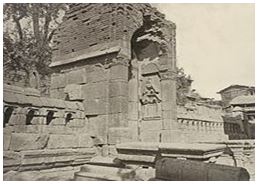
Gateway of enclosure, (once a Hindu temple) of Zein-ul-ab-ud-din’s Tomb, in Srinagar. Probable date AD 400 to 500, 1868. John Burke. Oriental and India Office Collection. British Library.
First Muslim Ruler, Shah Mir Swati
In the beginning of 14th century a ferocious Mongol, Dulucha, invaded the valley through its northern side ZojilaPass, with an army of 60,000 men. Like Taimur in the Punjab and Delhi, Dulucha carried sword and fire, destroyed towns and villages and slaughtered thousands. His savage attack practically ended the Hindu rule in Kashmir. Raja Sahadev was the ruler then. It was during his reign that three men, Shah Mir from Swat (tribal) territory on the borders of Afghanistan, Rinchin from Ladhak, and Lankar Chak from Dard territory near Gilgit came to Kashmir, and played a notable role in subsequentive political history of the valley. All the three men were granted Jagirs by the King. Rinchin for 3 years became the ruler of Kashmir.
After the King, Shams-ud-Din Shah Mir Swati was the first Muslim ruler of Kashmir and the founder of the Shah Miri dynasty named after him. Jonaraja, in his Rajatarangini mentioned him as Sahamera. He was a Pashtun, had come from Swat region, (then the) Tribal territory in Pakistan. Swat was on the borders of Afghanistan and played a notable role in subsequentive political history of the valley. Shahmir Swati became the ruler of Kashmir and reigned for three years.He was the first ruler of Swati dynasty, which had established in 1339. Shah Mir was succeeded by his eldest son Jamshid, but he was deposed by his brother Ali Sher probably within few months, who ascended the throne under the name of Alauddin[1]
Some Kashmiri rulers, such as Sultan Zain-ul-Abidin who was popularly known as Budshah(بڈشاہ) (the King) (r.1423-1474)[citation needed], were tolerant of all religions in a manner comparable to Akbar. However, several Muslim rulers of Kashmir were intolerant of other religions. SultãnSikandar Butshikan of Kashmir (AD 1389-1413) is often considered the worst of these. Historians have recorded many of his atrocities. The Tarikh-i-Firishta records that Sikandar persecuted the Hindus and issued orders proscribing the residence of any other than Muslims in Kashmir. He also ordered the breaking of all “golden and silver images”. The Tarikh-i-Firishta further states: “Many of the Brahmins, rather than abandon their religion or their country, poisoned themselves; some emigrated from their native homes, while a few escaped. After the emigration of the Brahmins, Sikandar ordered all the temples in Kashmir to be thrown down. Having broken all the images in Kashmir, (Sikandar) acquired the title of ‘Destroyer of Idols’.”[26]

Hazratbal shrine in Srinagar.
The metrical chronicle of the kings of Kashmir, called Rajatarangini, has been pronounced by Professor H.H.Wilson to be the only Sanskrit composition yet discovered to which the appellation “history” can with any propriety be applied. It first became known to the Muslims when, on Akbar’s invasion of Kashmir in 1588, a copy was presented to the emperor. A translation into Persian was made at his order. A summary of its contents, taken from this Persian translation, is given by Abul Fazl in the Ain-i-Akbari. The Rajatarangini was written by Kalhana about the middle of the 12th century. His work, in six books, makes use of earlier writings that are now lost.
The Rajatarangini is the first of a series of four histories that record the annals of Kashmir. Commencing with a rendition of traditional history of very early times, the Rajataranginicomes down to the reign of Sangrama Deva, (c.1006 AD). The second work, by Jonaraja, continues the history from where Kalhana left off, and, entering the Muslim period, gives an account of the reigns down to that of Zain-ul-Abidin, 1412[citation needed]. P. Srivara carried on the record to the accession of Fah Shah in 1486. The fourth work, called Rajavalipataka, byPrajnia Bhatta, completes the history to the time of the incorporation of Kashmir in the dominions of the Mogul emperor Akbar, 1588.
Shams-ud-Din Shah Mir was the First Muslim (Pashtun) ruler of Kashmir and the founder of the Shah Miri dynasty named after him. Jonaraja, in his Rajatarangini mentioned him as Sahamera. He came from Swat, a tribal territory on the borders of Afghanistan and rose to the position of Minister to the ruling Hindu king. At the king’s death, Shah Mir married the king’s widow and became the ruler of Kashmir,[13] reigning for three years as Shams-ud-Din and establishing the Kasmir Sultanate. He was the first ruler of the Swati dynasty, which was established in 1339.
Shah Mir was succeeded by his eldest son Jamshid, but he was deposed by his brother Ali Sher probably within few months, who ascended the throne under the name of Alauddin[1].
The subsequent history of the sultanate is a never-ending story of palace intrigues and the constant competition for power between two families, the Sayyids and the Chaks. During one period, 1484-1537, power reverted back and forth continually between the two families, so much so that Muhammad Shah (a Sayyid) had five different reigns and Fath Shah (a Chak) had three. At this time, the Lodi dynasty of Delhi got involved in Kashmir’s politics, although the effect was not long-lasting. Later, the Mughals also got involved. For a short stretch, an army from Kashgar under Haidar Dughlat invaded Kashmir and the sultan had to acknowledge the suzerainty of Said Khan of Kashgar.[14] Eventually, after Humayun recovered his Indian empire, Mughal influence once again became paramount, and Kashmir was finally absorbed into the Mughal empire during the reign of Akbar (around 1586).
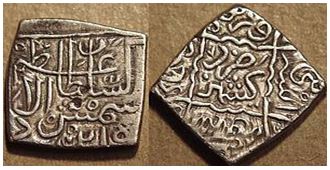
Silver sasnu of the Kashmir Sultan Shams al-Din Shah II (ruled 1537-38).
During the Sultanate period, the Kashmir sultans issued silver and copper coins. The silver coins were square and followed an unusual weight standard of approximately 6.2 gm.[15] The unusual weight of the coins (called sasnu or sansu) suggests that trade with other kingdoms was not a major part of the economy.
In the 14th century, Islam gradually became the dominant religion in Kashmir, starting with the conversion in 1323 of Rincana, the first king of the Sayyid Dynasty from Ladakh. The Muslims and Hindus of Kashmir lived in relative harmony, since the Sufi-Islamic way of life that ordinary Muslims followed in Kashmir complemented the Rishi tradition of Kashmiri Pandits. This led to a syncretic culture where Hindus and Muslims revered the same local saints and prayed at the same shrines. The famous sufi saint Bulbul Shah was able to persuade the king of the time Rinchan Shah from Ladakh to adopt the Islamic way of life, and the foundation of Sufiana composite culture was laid when Muslims, Hindus and Buddhists were co-existing.
Several Kashmiri rulers, such as Sultan Zain-ul-Abidin, were tolerant of all religions in a manner comparable to Akbar. However, several Muslim rulers of Kashmir were intolerant to other religions. Sultãn Sikandar Butshikan of Kashmir (AD 1389-1413) and his (former Brahmin) minister Saif ud-Din are often considered the worst of these. Historians have recorded many of his atrocities. The Tarikh-i-Firishta records that Sikandar persecuted the Hindus and issued orders proscribing the residence of any other than Muslims in Kashmir.
Sikh rule
In 1819, the Kashmir valley passed from the control of the Durrani Empire of Afghanistan, and four centuries of Muslim rule under the Mughalsand the Afghans, to the conquering armies of the Sikhs under Ranjit Singh of Lahore.[27] As the Kashmiris had suffered under the Afghans, they initially welcomed the new Sikh rulers.[28] However, the Sikh governors turned out to be hard taskmasters, and Sikh rule was generally considered oppressive,[29] protected perhaps by the remoteness of Kashmir from the capital of the Sikh empire in Lahore;[30] The Sikhs enacted a number of anti-Muslim laws,[30] which included handing out death sentences for cow slaughter,[28] closing down the Jamia Masjidin Srinagar,[30] and banning the azaan, the public Muslim call to prayer.[30] Kashmir had also now begun to attract European visitors, several of whom wrote of the abject poverty of the vast Muslim peasantry and of the exorbitant taxes under the Sikhs.[28] High taxes, according to some contemporary accounts, had depopulated large tracts of the countryside, allowing only one-sixteenth of the cultivable land to be cultivated.[28] However, after a famine in 1832, the Sikhs reduced the land tax to half the produce of the land and also began to offer interest-free loans to farmers;[30] Kashmir became the second highest revenue earner for the Sikh empire.[30] During this time Kashmiri shawlsbecame known world wide, attracting many buyers especially in the west.[30]
Earlier, in 1780, after the death of Ranjit Deo, the Raja of Jammu, the kingdom of Jammu (to the south of the Kashmir valley) was also captured by the Sikhs and afterwards, until 1846, became a tributary to the Sikh power.[27] Ranjit Deo’s grandnephew, Gulab Singh, subsequently sought service at the court of Ranjit Singh, distinguished himself in later campaigns, especially the annexation of the Kashmir valley, and, for his services, was appointed governor of Jammu in 1820. With the help of his officer, Zorawar Singh, Gulab Singh soon captured for the Sikhs the lands of Ladakh and Baltistan to the east and north-east, respectively, of Jammu.[27]
Princely State of Kashmir and Jammu
Main article: Kashmir and Jammu

Sheikh Imam-ud-din along with Ranjur Singh and Dewan Dina Nath. 1847. (James Duffield Harding) Sheikh Imam-ud-din was the governor of Kashmir under the Sikhs, and fought on the side of the English in the battle of Multan during the First Anglo-Sikh War (1845-46).
By the early 19th century, the Kashmir valley had passed from the control of the Durrani Empire of Afghanistan, and four centuries of Muslim rule under the Mughals and the Afghans, to the conquering Sikh armies. Earlier, in 1780, after the death of Ranjit Deo, the Raja of Jammu, the kingdom of Jammu (to the south of the Kashmir valley) was captured by the Sikhs under Ranjit Singh of Lahore and afterwards, until 1846, became a tributary to the Sikh power.[16] Ranjit Deo’s grandnephew, Gulab Singh, subsequently sought service at the court of Ranjit Singh, distinguished himself in later campaigns, especially the annexation of the Kashmir valley by the Sikhs army in 1819, and, for his services, was created Raja of Jammu in 1820. With the help of his officer, Zorawar Singh, Gulab Singh soon captured Ladakh and Baltistan, regions to the east and north-east of Jammu.[16]
British era
In 1845, the First Anglo-Sikh War broke out, and Gulab Singh “contrived to hold himself aloof till the battle of Sobraon (1846), when he appeared as a useful mediator and the trusted advisor of Sir Henry Lawrence. Two treaties were concluded. By the first the State of Lahore (i.e. West Punjab) handed over to the British, as equivalent for (rupees) one crore of indemnity, the hill countries between Beas and Indus; by the second[17] the British made over to Gulab Singh for (Rupees) 75 lakhs all the hilly or mountainous country situated to the east of Indus and west of Ravi” (i.e. the Vale of Kashmir).[16] Soon after Gulab Singh’s death in 1857, his son, Ranbir Singh, added the emirates of Hunza, Gilgit and Nagar to the kingdom.
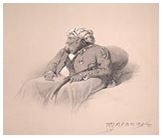
Portrait of Maharaja Gulab Singh in 1847, a year after signing the Treaty of Amritsar, when he became Maharaja by purchasing the territories of Kashmir “to the eastward of the river Indus and westward of the river Ravi”[18] for 75 lakhs rupees from the British (Artist: James Duffield Harding).
The Princely State of Kashmir and Jammu (as it was then called) was constituted between 1820 and 1858 and was “somewhat artificial in composition and it did not develop a fully coherent identity, partly as a result of its disparate origins and partly as a result of the autocratic rule which it experienced on the fringes of Empire.”[19] It combined disparate regions, religions, and ethnicities: to the east, Ladakh was ethnically and culturally Tibetan and its inhabitants practised Buddhism; to the south, Jammu had a mixed population of Hindus, Muslims and Sikhs; in the heavily populated central Kashmir valley, the population was overwhelmingly Sunni Muslim, however, there was also a small but influential Hindu minority, the Kashmiri brahmins or pandits; to the northeast, sparsely populated Baltistan had a population ethnically related to Ladakh, but which practised Shi’a Islam; to the north, also sparsely populated, Gilgit Agency, was an area of diverse, mostly Shi’a groups; and, to the west, Punch was Muslim, but of different ethnicity than the Kashmir valley.[19] After the Indian Rebellion of 1857, in which Kashmir sided with the British, and the subsequent assumption of direct rule by Great Britain, the princely state of Kashmir came under the paramountcy of the British Crown.


List of Maharajas (1846-1949)
Main article: The Royal House of Jammu and Kashmir
- Gulab Singh (1846–1857)
- Ranbir Singh (1857–1885)
- Pratap Singh (1885–1925)
- Hari Singh (1925–1949)
Year 1947 and 1948
Further information: Kashmir conflict, Timeline of the Kashmir conflict, and Indo-Pakistani War of 1947
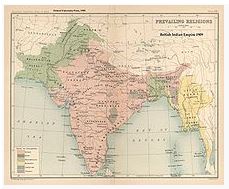
The prevailing religions by district in the 1901 Census of the Indian Empire.
Ranbir Singh’s grandson Hari Singh, who had ascended the throne of Kashmir in 1925, was the reigning monarch in 1947 at the conclusion of British rule of the subcontinent and the subsequentpartition of the British Indian Empire into the newly independent Union of India and the Dominion of Pakistan. According to Burton Stein’s History of India,
“Kashmir was neither as large nor as old an independent state as Hyderabad; it had been created rather off-handedly by the British after the first defeat of the Sikhs in 1846, as a reward to a former official who had sided with the British. The Himalayan kingdom was connected to India through a district of the Punjab, but its population was 77 per cent Muslim and it shared a boundary with Pakistan. Hence, it was anticipated that the maharaja would accede to Pakistan when the British paramountcy ended on 14–15 August. When he hesitated to do this, Pakistan launched a guerrilla onslaught meant to frighten its ruler into submission. Instead the Maharaja appealed to Mountbatten[35] for assistance, and the governor-general agreed on the condition that the ruler accede to India. Indian soldiers entered Kashmir and drove the Pakistani-sponsored irregulars from all but a small section of the state. The United Nations was then invited to mediate the quarrel. The UN mission insisted that the opinion of Kashmiris must be ascertained, while India insisted that no referendum could occur until all of the state had been cleared of irregulars.”[36]
In the last days of 1948, a ceasefire was agreed under UN auspices, but since the plebiscite demanded by the UN was never conducted, relations between India and Pakistan soured,[36] and eventually led to two more wars over Kashmir in 1965 and 1999. India has control of about half the area of the former princely state of Jammu and Kashmir, while Pakistan controls a third of the region, the Northern Areas and Azad Kashmir. According to Encyclopædia Britannica, “Although there was a clear Muslim majority in Kashmir before the 1947 partition and its economic, cultural, and geographic contiguity with the Muslim-majority area of the Punjab (in Pakistan) could be convincingly demonstrated, the political developments during and after the partition resulted in a division of the region. Pakistan was left with territory that, although basically Muslim in character, was thinly populated, relatively inaccessible, and economically underdeveloped. The largest Muslim group, situated in the Valley of Kashmir and estimated to number more than half the population of the entire region, lay in Indian-administered territory, with its former outlets via the Jhelum valley route blocked.”[37]

The Karakash River (Black Jade River) which flows north from its source near the town of Sumde in Aksai Chin, to cross theKunlun Mountains.
The Histories by year basis

1909 Map of the Princely State of Kashmir and Jammu. The names of different regions, important cities, rivers, and mountains are underlined in red.
The metrical chronicle of the kings of Kashmir, called Rajatarangini, has (erroneousy) been pronounced by Professor H.I. Wilson to be the only Sanskrit composition yet discovered to which the appellation “history” can with any propriety be applied. It first became known to the Muslims when, on Akbar’s invasion of Kashmir in 1588, an amalgamated version was presented to the emperor. A translation into Persian was made at his order. A summary of its contents, taken from this Persian translation, is given by Abul Fazl in the Ain-i-Akbari. The Rajatarangini was written by Kalhana in the middle of the 12th century. His work, in eight books, makes use of earlier writings that are now lost.
The Rajatarangini is the first of a series of four histories that record the annals of Kashmir. Commencing with a rendition of traditional ‘history’ of very early times (3102 BC), the Rajatarangini comes down to the reign of Sangrama Deva, (c.1006 AD) and Kalhana. The second work, by Jonaraja, continues the history from where Kalhana left off, and, entering the Muslim period, gives an account of the reigns down to that of Zain-ul-ab-ad-din, 1412. P. Srivara carried on the record to the accession of Fah Shah in 1486. The fourth work, called Rajavalipataka, by Prajnia Bhatta, completes the history to the time of the incorporation of Kashmir in the dominions of the Mogul emperor Akbar, 1588.
The History time basis are below
| 1947: August 14/15. British India is partitioned into India and Pakistan as part of the independence process. Majority Muslim areas in the West (now all of Pakistan) and East (the place now called Bangladesh) form Pakistan. The British also allow the nominal rulers of several hundred “princely states,” who were tax collectors for the British and served at British pleasure, to decide whether they wanted to join India or Pakistan. Pakistan demands Kashmir accede to it. The Hindu ruler of Kashmir does not make a choice. Kashmir has three major ethnic areas: Ladakh in the northwest, which is majority Buddhist; the Kashmir Valley (controlled by India) and the part now controlled by Pakistan, which is majority Muslim, and Jammu (in the south), which is majority Hindu. The overall majority is Muslim.1948: “Tribesmen” from Pakistan invade Kashmir with the support of the Pakistani government. The ruler of Kashmir asks India for help. India demands that Kashmir should accede to India first. The ruler agrees. India sends forces to Kashmir and the invasion is blocked. Kashmir is divided into a Pakistani controlled part and an Indian controlled part. This de facto partition continues to this date with the dividing line being known as the Line of Control. 1948: India takes the Kashmir issue to the U.N. Security Council, which passes a resolution calling on Pakistan to do all it can “secure the withdrawal” of Pakistani citizens and “tribesmen” and asking that a plebiscite be held to determine the wishes of the people of Kashmir. Neither the force withdrawal nor the plebiscite has taken place. 1962: India and China fight a border war. China occupies a part of Ladakh. 1965: India and Pakistan fight a border war along the India-West Pakistan border and the Line of Control in Kashmir. U.N. brokered cease fire and withdrawal to pre-war lines affirmed by the leaders of the two countries at a 1966 summit meeting in Tashkent, USSR (now Toshkent, Uzbekistan). 1970-1971: An election in (East and West) Pakistan results in an overall majority for an East Pakistani party, which is ethnically mainly Bengali. The Pakistani military refuses to allow the Parliament to convene. East Pakistanis demand autonomy, then independence in the face of brutal repression by the Pakistani military. Guerilla warfare ensues. About ten million refugees stream into India from East Pakistan. India also provides sanctuary to Bangladeshi guerillas. Pakistan attacks airfields in India and Indian-controlled Kashmir. India strikes back in West Pakistan and also intervenes in the East on the side of the Bangladeshis. The U.S., in a “tilt” towards Pakistan, sends a nuclear-armed aircraft carrier, the Enterprise, and its battlegroup, to the region, in an implicit nuclear threat to India (which influences nuclear politics of India in favor of nuclear testing). Pakistan loses the war on both fronts and Bangladesh becomes independent. 1972: India and Pakistan sign a peace accord, known as the Simla (or Shimla) agreement, according to which both sides agree “to settle their differences by peaceful means through bilateral negotiations or by any other peaceful means mutually agreed upon between them.” Both countries agree that they will not unilaterally try to alter the Line of Control in Kashmir. 1974: India tests a nuclear device. Pakistan accelerates its nuclear weapons program. 1980s: U.S. supports Islamic resistance to Soviet occupation of Afghanistan and also the dictatorship of Zia-ul-Haq in Pakistan, which promotes Islamic fundamentalism in Pakistan. Late 1980s: There is a state-level election in the Indian-controlled portion of Kashmir. There is evidence of fraud. Militancy rises in Kashmir. In 1989, the Soviets quit Afghanistan. Islamic militants from outside South Asia now become engaged in Kashmir, with the support of the Pakistani government. The violence in Kashmir becomes more dominated by foreign fighters and by religious fundamentalism. In the late 1980s and early 1990s, Hindu fundamentalism begins to become more powerful as a political force in India. 1990s: Violence intensifies in Kashmir. Islamic militants carry out ethnic cleansing in the KashmirValley, terrorizing non-Muslims, mainly Kashmiri pundits, causing large numbers of people to flee, mainly to Jammu. Pakistan supports the cross border infiltration. The Indian military responds with repression to the terrorism, foreign infiltration, and the domestic insurgency, which are now all mixed up. There are serious human rights abuses on all sides. 1998: A coalition led by the Hindu-fundamentalist party, the BJP, comes to power in India. India and Pakistan carry out nuclear weapons tests and declare themselves nuclear weapon states. Pakistan announces that it may, under certain circumstances, use nuclear weapons first to neutralize India’s conventional superiority, making reference to NATO’s Cold War doctrine of potential first use in case of a European war with the Soviets. India says it will not use nuclear weapons first. 1999: Indian Prime Minister, Atal Behari Vajpayee, travels to Lahore, Pakistan for a peace meeting with Prime Minister Nawaz Sharif. There is great hope for peace. Three months later Pakistan-based militants invade the Kargil area in Indian-controlled Kashmir, with the support of the military. A military confrontation, with the possibility of nuclear war, ensues. Nawaz Sharif travels to Washington and President Clinton convinces him to withdraw Pakistani forces from Kargil. Confrontation ends. Nawaz Sharif is overthrown in a military coup led by General Musharraf, one of the architects of the Kargil war. (Musharraf proclaims himself President of Pakistan in the year 2000.) September 11, 2001: Well-known tragic events in the United States. Terrorist attacks kill about 3,000 people. October 1, 2001: A terrorist attack on the Kashmir state legislature in Srinagar. 38 people are killed. October 7, 2001: U.S. launches a war in Afghanistan, under the rubric of the War on Terrorism. President Musharraf becomes a U.S. ally and allows Pakistan to become a base of operations for the United States. Al Qaeda, Taliban, and their supporters in Pakistan feel severe pressure. December 13, 2001: A terrorist attack on India’s Parliament. Fourteen people (including five attackers, as well as security guards and two civilians) are killed. Aftermath of December 13: India mobilizes and moves hundreds of thousands of soldiers to the border with Pakistan, including the Line of Control in Kashmir. The danger of conventional and nuclear war rises. May 14, 2002 to date (early Sept 2002): A terrorist attack on families of Indian servicemen. More than 30 people killed. India threatens to retaliate. Pakistan makes implicit threats of nuclear weapons use in case of Indian attack. Peak of the conventional and nuclear confrontation reached in May-June 2002. Greatest threat of nuclear war since the Cuban missile crisis of 1962. U.S. troops and war strategy in the region imperiled. U.S. shuttle diplomacy defuses the immediate crisis as Pakistan promises to end cross border infiltration. India does not retaliate. Tensions remain high and the threat of war and nuclear weapons use persists |
History: The Roots
Considering only the present and forsaking the past is to take a very narrow view of the reality. For to be careful of the present without being informed of the past is to have a deceptive view of things. Cicero rightly observed, “Not to know what took place before you were born is to remain for ever a child.” Peeping into the history one gets account of the periods Kashmir has passed through. The book namely Rajatarangini (River of Kings) written by Khalana in 1148-50 A.D. provides insight to the entire period of ancient Kashmir. It gives a fairly accurate and exhaustive account of the events and social and economic conditions from the eighth century onwards.
History of Kashmir can be understood by going through following periods:
Period of Hindu and Buddhist Kings.
Period of Muslim Sultans. Period of Mughals. Period of Afghans. Period of Sikhs. Period of Dogras.
Although Jammu, Kashmir and Ladakh were separate provinces having no link with each another, all the three were joined during the Dogra period. Gulab Singh, the fonder of Dogra dynasty hailing from Jammu was taken into service by Maharaja Ranjit Singh. Gulab Singh’s exemplary courage and loyalty towards Ranjit Singh credited him with the title of Raja and he was given the permission to raise his own force.
Gulab Singh included Ladakh in his own province in 1834 with the implied consent of Ranjit Singh and East India Company. Ladakh, the most strategic area having borders with China and Tibet were an independent Kingdom under the suzerainty of Grand Lamas of Tibet till then.
After the death of Ranjit Singh, Gulab Singh by virtue of his ability and good fortune entered into a deal with Britishers through Treaty of Amritsar (March 16, 1846). In this treaty the British government transferred for ever an independent possession of some of ceded areas, including Kashmir to Gulab Singh for his willingness to pay rupees 75 Lac out of the total amount of indemnity demanded by the British. With this the state of J&K comes into being.
The Dogra dynasty lasted for a period of over hundred years and saw four Maharajas – Gulab Singh (1846-57); Ranbir Singh (1857-85); Pratap Singh (1885-1925) and Hari Singh (1925-52).
At the time of commencement of Dogra rule, the conditions in Kashmir were deplorable. Baron Schonberg, who traveled the valley at that time, observed, “I have been in many lands but nowhere the conditions of human beings present a more saddening spectacle than in Kashmir. It vividly recalled the history of Israelites under the Egyptian rule, when they were flogged at their daily labour by their pitiless task masters.”
That was the time forced labour was prevalent and the wages of the artisans were very low. Most of the people lived on a small quantity of rice. Gulab Singh employed stern, often inhuman, measures to restore order.
The year 1931 requires a special mention for this was the time movement against Dogra rule (autocracy) started. For the first time in the history of Kashmir people openly opposed the oppression from the rulers. Same year July 13, twenty one (21) Kashmiri Muslims fell to the bullets of tyrannical soldiers outside Srinagar central jail. This year marks the saga of sacrifices and that go on continuing.
1932: Sheikh Mohammed Abdullah and Mirwaiz Mohammed Yosuf Shah form the All Jammu and Kashmir Muslim Conference.
1939: Muslim Conference is formally dissolved and Sheikh Mohammed Abdullah sets up the J&K National Conference (NC).
1946: National Conference launches the Quit Kashmir movement, directed at the abrogation of the Treaty of Amritsar. Sheikh Mohammed Abdullah is arrested. 1947: In August when Indian subcontinent became independent from Britain, all the rulers of 565 princely states had to decide which of the new dominions to join, India or Pakistan?
The ruler of Jammu and Kashmir, whose state was situated between the two new countries, could not decide which country to join. He was Hindu, his population was predominantly Muslim. He therefore did nothing and pretended an attack of colic, which had spared him the decision Lord Mountbatten, the then Governor-General had wanted him to take before August 14.
Instead he signed a “standstill” agreement with Pakistan in order that services such as trade, travel and communication would be uninterrupted. India did not sign a similar agreement.
Same year on October 22, Pashtun tribesmen from Pakistan’s North WestFrontierProvince invaded Kashmir, hearing communal violence against Muslims in the state and eager to precipitate its accession to Pakistan.
Lord Mountbatten believed the developing situation would be less explosive if the state were to accede to India, on the understanding that this would only be temporary prior to “a referendum, plebiscite, election.”
According to the terms of the Instrument of Accession, Indian’s jurisdiction was to extend to external affairs, defence and communication.
Exactly when did Hari Singh sign the Instrument of Accession, has been hotly debated for over 59 years. Official Indian accounts state that in the early hours of the morning of October 26, Hari Singh fled from Srinagar, arriving in Jammu later in the day, where he was met by V P Menon, representative of Prime Minister Jawaharlal Nehru, and signed the Instrument of Accession. On the morning of October 27, Indian troops were airlifted in to Srinagar to repel Pakistani’s raiders.
However a research from British sources quoted by Victoria Schofield, author of Kashmir in Conflict has indicated that Hari Singh did not reach Jammu until the evening of October 26 and that due to poor flying conditions, V P Menon was unable to get to Jammu until the morning of October 27, by which time Indian troops were already arriving in Srinagar.
Pakistan immediately contested the accession, suggesting that it was fraudulent, that the Maharaja acted under duress and that he had no right to sign an agreement with India, when “standstill” agreement with Pakistan was already in force.
Pakistani’s also argued that because Hari Singh fled from the valley of Kahmir, he was not in control of his state and therefore not in a position to take a decision on behalf of his people.
In the context of the Pakistan’s claim that there is a dispute over the State of Jammu and Kashmir, the accession issue forms a significant aspect of their agreement.
However Jagmon in his book My Frozen Turulence in Kashmir quotes gists of Maharaja Hari Singh’s letter of October 26, 1947 to Lord Mountbatten and latter’s reply to Maharaja on October 27, 1947, which reads as:
Maharaja Hari Singh said: “With the conditions obtaining at present in my State and the great emergency of situation as it exists, I have no option but to ask for help from Indian Dominion. Naturally they can not send the help asked for by me without my State acceding to the Dominion of India. I have accordingly decided to do so and I attach the Instrument of Accession for acceptance by your Government.”
Lord Mountbatten in reply to Maharaja’s letter writes: “In the special circumstances mentioned by Your Highness, my government has decided to accept the accession of KashmirState to the Dominion of India. It is my government’s wish that as soon as law and order have been restored in Kashmir and her soil cleared of the invaders, the question of State’s accession should be settled by a reference to the people. Meanwhile, in response to Your Highness’s appeal for military aid, action has been taken today to send troops of the Indian Army to Kashmir to help your own forces to defend your territory and to protect the lives, property and honour of your people.”
On the basis of Maharaja’s “accession” India claims ownership of the entire State which includes the approximately one third of the territory currently administered by Pakistan.
The tribal raiders from North WestFrontierProvince descended on Baramullah, only 30 miles from Srinagar on October 24-26. Overtaken by their wild habits, they indulged in large scale looting, burning, raping and killing. All day, Monday October 27, while the Ist Sikhs of Indian troops secured their fragile hold on Kashmir’s only airport, the Pathan’s in Baramullah were giving vent to their ancient appetites for rape and pillage. They violated the nuns, massacred the patients in their little clinic, looted the convent chapel down to its last brass knob.
By the time Pathans resumed to their attack, it was too late. The raiders hardly realized that the time spent by them in committing their abominable crimes would turn out to be their punishment as it enabled the Indian forces to land at Srinagar airport on October 27 and ultimately push back the raiders inflicting heavy casualities on them. Sheikh Mohammed Abdullah is appointed head of the Emergency Administration.
November 6, 1947: Two Lac. Muslims were massacred in the city of temples (Jammu) and elsewhere in the region. More than one million people were forced to migrate to Pakistan. The carnage changed the demographic complexion of the region.
1948 : India takes the Kashmir problem to the United Nations Security Council on January 1 and offers to hold a plebiscite under UN supervision, after the raiders are moved back. On March 4, S M Abdullah was appointed Prime Minister of J&K with a Council of ministers. On August 13, a UN commission proposes that the State’s future be decided in accordance with the will of people. On December 20, Pakistan also accepts the UN resolution.
1949: A ceasefire between Indian and Pakistani forces leaves 84,000 sq.km under Pakistani control. On October 17, Indian constituent Assembly adopts Article 370 of the constitution, ensuring a special status for J&K.
1950: On March 14 UN Security Council decided to appoint a representative of the commission to carry out its work. Sir Owen Dixon was the first holder of this assignment. He formulated what is known as the ‘Dixon Plan’. The plan envisaged virtual partition of the state. Dixon held that the entire area of Jammu and Kashmir could be divided into three regions,
i) the region about which there was no doubt that it wished to accede to India
ii) the region about which there was no doubt that it wished to accede to Pakistan
iii) the region in respect of which there could be doubt about its wishes
He recommended that a plebiscite should be held only in regards the region falling in the third category. The ‘Dixon Plan’ was rejected both by India and Pakistan
1951: An interim constitution for the state comes into effect in November
1952: An agreement is arrived at on July 24 between Sheikh Abdullah and Government of India which provides for the states autonomy within India. This agreement made provision for the state like J&K to have its own flag. The year also saw acrimony growing between Sheikh Abdullah and India, with the former criticizing latter for communal nature and even on July 13, Sheikh declared that interference of New Delhi in affairs of the state wont be tolerated.
1953: The New York Times in its July 5 issue published a map hinting at the independent status of the valley. On July 13 Sheikh commented that, “It is not necessary that our state should become an appendage of either India or Pakistan.” On August 9, Sheikh Abdullah is dismissed and arrested. Bakshi Ghualm Mohammed becomes the Prime Minister. The governments of India and Pakistan agree to appoint a plebiscite administrator by the end of April 1954.
1955: Violence and demonstrations across the valley occur on December 27, when the holy relic is found missing from the Hazratbal Shrine
1964: The holy relic is recovered on January 4. Protest demonstration occur in Kashmir on December 21, against articles 356 and 357 of the Indian constitution being extended to the state.
1965: India and Pakistan go to war, after armed Pakistani infiltrators cross the ceasefire line on August 5, and the international border in Chamb in September. The war ends in a ceasefire on September 23. The denominations ‘Prime Minister’ and ‘Sadr e Riyasat’ are changed to ‘Chief Minister’ and ‘Governor’ respectively through an amendment of the J&K constitution with effect from May 30 1965. Prime Minister G M Sadiq becomes Chief Minister.
1966: Al Faleh comes into being with a call of Independent Kashmir. Tashkent declaration on Jan 10.
1975: Sheikh Abdullah sworn in as chief minister on Feb 25, with support of Congress Legistature Party.
1977: On June 30, elections in J&K are held. Authorities claim free and fair elections but critics like Prem Nath Bazaz call them manipulated
1981: Sheikh Abdullah nominates his son Farooq as his political heir
1982: Sheikh Mohammed Abdullah dies on Sept 8. Farooq Abdullah Sworn in as the chief minister. J & K grant of permit for Resettlement Act, 1982 given with the aim to provide for the resettlement of Nov 6, 1947 victims who migrated to PoK or Pakistan itself. On October 4 bill passed by the assembly for the second time with Farooq Adullah the Chief Minister.
1983: Congress starts campaign to discredit Farooq Abdullah and his victory in assembly elections in June. Relations with Farooq and Mrs Indira Gandhi worsened as former kept association with the opposition parties and invited them to a conclave in Srinagar within months of becoming chief minister. Three bomb explosions in Srinagar
1984: Indian authorities hang to death Maqbool Bhat, founder member of Jammu Kashmir Liberation Front (JKLF) on February 11. He was charged for killing two intelligence officers besides indulging in anti-national activities.
1986: Shah government dismissed on March 7. By November Farooq is back in power after coming to an agreement with Rajiv Gandhi.
1987: The Muslim United Front comes into being in January when various organizations come together to oppose the National Conference-Congress electoral alliance. Farooq wins elections in March but faces allegations of rigging.
1988: Protests begin in valley along with anti India demonstrations. At least 10 people are killed and curfew is placed in the valley in August. On Aug 2 youth wing of National Conference submitted a memorandum to Governor Jagmohan to request President of India to accord assent to the resettlement bill which was paused by state legislature.
1989: JKLF emerges with the call of independence. Violence begins with bomb explosions rocking the city. Rubaiya Sayeed, daughter of home minister of India, Mufti Mohammed Sayeed kidnapped by JKLF.
On Dec 13, Rubaiya is released in exchange of 5 JKLF men, whose release from the prison results in victory celebrations in Srinagar. Two days later curfew is placed in the valley after 5 people are killed in police firing.
1990: Farooq Abdullah resigns. On Jan 20 around 100 people are killed (official figure 35) when protestors seeking freedom from Indian occupation are fired upon from both sides of Gawkadal bridge in Srinagar. In March mass exodus of Kashmiri Pandits takes place.
1991: May 21, Mirwaiz Molvi Mohammed Farooq assassinated. The violence continues.
1992: Jan 26, BJP Ekta Yatra is allowed to hoist the Indian flag in Lal chowk, under total curfew and massive security. The violence continues, spreading to the areas of Jammu province like Doda. Jammu and Kashmir Hizbul Mujahideen (JKHM) which strives for merger of J&K with Pakistan increases its strength dramatically. Differences arise between JKHM and JKLF. Other militant organizations proliferate. Allegations of human rights violations by the Indian soldiers increase
1993: In Jan 40 people are killed in Sopore by Indian soldiers who burn down a section of the town after two of their men are killed. In April state policemen go on strike after a constable Riyaz Ahmed is killed in army custody. In October militants inside Hazratbal Shrine are surrounded by security forces. After several days of siege Indian soldiers open fire on protestors in Bijbehara on October 22 killing about 43 and injuring more than 100.
1994: Association of Parents of Disappeared comes into being to impress upon the government to disclose the whereabouts of persons subjected to enforced disappearances by Indian soldiers and to put an end to this practice.
1997 Indian and Pakistani leaders meet several times to discuss the diffusion of tension in Kashmir. 1997 Indian and Pakistani leaders meet several times to discuss the diffusion of tension in Kashmir.
1998 In May, India conducts underground nuclear tests near the Pakistani border which are met by international condemnation. Pakistan conducts similar tests three weeks later.
1999: The Indian Army patrols detect intruders on Kargil ridges in Kashmir and India fights to regain lost territory. Two months later Pakistani and Indian military officials agree to end the fighting in the region and disengage their forces.
2001: In May India ends a six-month military ceasefire against Islamic guerillas in Kashmir while also inviting Pakistani military ruler, General Pervez Musharraf, to peace talks. Pakistani President General Pervez Musharraf and Indian Prime Minister Atal Behari Vajpayee meet in Agra, in July for a three-day summit. The talks fail to produce a joint statement on Kashmir.
In October Militants attack the Kashmiri assembly in Srinagar, leaving 38 people dead. Kashmir chief minister Farooq Abdullah urges the Indian government to launch a crackdown on militant training camps across the border in Pakistan.
On December 13, 2001 Unidentified men attack the Indian Parliament in New Delhi, leaving 14 dead, including the attackers.
2002: The row over the parliament attack triggers military build-up, diplomatic sanctions, and closure of transport links between the two nations. In May militants attack an army camp in Indian Kashmir, killing more than 30 people and ruining a new effort to ease the tension between India and Pakistan. India’s Prime Minister Atal Behari Vajpayee visits the front lines. In a speech to soldiers on the border with Pakistan he says that the time is right for a decisive battle. In October four rounds of polls to choose a new governemnt conclude in Indian-controlled Kashmir. About 500 people are killed during the blood-soaked election campaign.
2003: Indian prime minister Atal Behari Vajpayee offers “hand of friendship” to Pakistan in a landmark address in Indian-administered Kashmir. In May India announces the resumption of a bus service between Delhi and Lahore. Diplomatic links are resumed. Heavily armed militants attack the Chief Minister’s residence at high security zone of Lal Chowk in Srinagar. Several soldiers are killed but Chief Minister Mufti Mohammed Sayeed not at home at the time of the attack. After years of refusing to talk to Kashmiri separatist groups, India announces it is prepared to hold negotiations with the All Parties Hurriyat Conference In November India agrees to a Pakistani offer of a cease-fire along their borders in the disputed region of Kashmir. The cease-fire goes into effect November 26.
2005: First passengers from either side of the Line of Control cross divided Kashmir on April 7 as the first Srinagar Muzaffarabad Bus Service is launched. On October 8 a massive earthquake measuring 7.6 on the Richter scale causes widespread devastation mostly in Pakistan admnistered Kashmir and parts under Indian control. Five points are opened along the line of control for exchange of relief material and cross over of quake survivors.
1947
Instrument of Accession, with signatures of Maharaja Hari Singh of Jammu and Kashmir, and Viscount Mountbatten of Burma, Governor-General of India.
Ranbir Singh’s grandson Hari Singh, who had ascended the throne of Kashmir in 1925, was the reigning monarch in 1947 at the conclusion of British rule of the subcontinent and the subsequent partition of the British Indian Empire into the newly independent Union of India and the Dominion of Pakistan. An internal revolt began in the Poonch region against oppressive taxation by the Maharaja.[20] In August, Maharaja’s forces fired upon demonstrations in favour of Kashmir joining Pakistan, burned whole villages and massacred innocent people.[21] The Poonch rebels declared an independent government of “Azad” Kashmir on 24 October.[22] Rulers of Princely States were encouraged to accede their States to either Dominion – India or Pakistan, taking into account factors such as geographical contiguity and the wishes of their people. In 1947, Kashmir’s population was “77% Muslim and 20% Hindu”.[23] To postpone making a hurried decision, the Maharaja signed a “standstill” agreement with Pakistan, which ensured continuity of trade, travel, communication, and similar services between the two. Such an agreement was pending with India.[24] In October 1947, Pashtuns from Pakistan’s North-West Frontier Province recruited by the Poonch rebels, invaded Kashmir, along with the Poonch rebels, allegedly incensed by the atrocities against fellow Muslims in Poonch and Jammu. The tribesmen engaged in looting and killing along the way.[25] The ostensible aim of the guerilla campaign was to frighten Hari Singh into submission. Instead the Maharaja appealed to Mountbatten[26] for assistance, and the Governor-General agreed on the condition that the ruler accede to India.[23] Once the Maharaja signed the Instrument of Accession, Indian soldiers entered Kashmir and drove the Pakistani-sponsored irregulars from all but a small section of the state. India accepted the accession, regarding it provisional[27] until such time as the will of the people can be ascertained by a plebiscite, since Kashmir was recognized as a disputed territory. Kashmir leader Sheikh Abdullah endorsed the accession as ad-hoc which would be ultimately decided by a plebiscite and is appointed head of the emergency administration.[28] The Pakistani government immediately contested the accession, suggesting that it was fraudulent, that the Maharaja acted under duress and that he had no right to sign an agreement with India when the standstill agreement with Pakistan was still in force.
See also: Indo-Pakistani War of 1947, The Accession of the Princely States
Post-1947
The United Nations was then invited to mediate the quarrel. The UN mission insisted that the opinion of Kashmiris must be ascertained. The then Indian Prime Minister is reported to have himself urged U.N. to poll Kashmir and on the basis of results Kashmar’s accession will be decided.[29] However, India insisted that no referendum could occur until all of the state had been cleared of irregulars.[23] On 5 January 1949, UNCIP (United Nations Commission for India and Pakistan) resolution stated that the question of the accession of the State of Jammu and Kashmir to India or Pakistan will be decided through a free and impartial plebiscite.[30] As per the 1948[31] and 1949 UNCIP Resolutions, both countries accepted the principle, that Pakistan secures the withdrawal of Pakistani intruders followed by withdrawal of Pakistani and Indian forces, as a basis for the formulation of a Truce agreement whose details are to be arrived in future, followed by a plebiscite; However, both countries failed to arrive at a Truce agreement due to differences in interpretation of the procedure for and extent of demilitarisation one of them being whether the Azad Kashmiri army is to be disbanded during the truce stage or the plebiscite stage.[32]
In the last days of 1948, a ceasefire was agreed under UN auspices; however, since the plebiscite demanded by the UN was never conducted, relations between India and Pakistan soured,[23] and eventually led to three more wars over Kashmir in 1965, 1971 and 1999. India has control of about half the area of the former princely state of Jammu and Kashmir; Pakistan controls a third of the region, the Northern Areas, or historically known as regions of Gilgit and Baltistan; and Pakistan Administered Kashmir. According to Encyclopædia Britannica, “Although there was a clear Muslim majority in Kashmir before the 1947 partition and its economic, cultural, and geographic contiguity with the Muslim-majority area of the Punjab (in Pakistan) could be convincingly demonstrated, the political developments during and after the partition resulted in a division of the region. Pakistan was left with territory that, although basically Muslim in character, was thinly populated, relatively inaccessible, and economically underdeveloped. The largest Muslim group, situated in the Vale of Kashmir and estimated to number more than half the population of the entire region, lay in Indian-administered territory, with its former outlets via the Jhelum valley route blocked.”[33]

Cease-fire line between India and Pakistan after the 1947 conflict
The UN Security Council on 20 January 1948 passed Resolution 39 establishing a special commission to investigate the conflict. Subsequent to the commission’s recommendation the Security Council, ordered in its Resolution 47, passed on 21 April 1948 that the invading Pakistani army retreat from Jammu & Kashmir and that the accession of Kashmir to either India or Pakistan be determined in accordance with a plebiscite to be supervised by the UN. In a string of subsequent resolutions the Security Council took notice of the continuing failure by India to hold the plebiscite. However, no punitive action against India could be taken by the Security Council because its resolution, requiring India to hold a Plebiscite, was non-binding and the Pakistani army never left the part of the Kashmir, they managed to keep occupied at the end of the 1947 war, required by the Security Council resolution 47.[34]
The eastern region of the erstwhile princely state of Kashmir has also been beset with a boundary dispute. In the late 19th- and early 20th centuries, although some boundary agreements were signed between Great Britain, Afghanistan and Russia over the northern borders of Kashmir, China never accepted these agreements, and the official Chinese position did not change with the communist takeover in 1949. By the mid-1950s the Chinese army had entered the north-east portion of Ladakh.[33] : “By 1956–57 they had completed a military road through the Aksai Chin area to provide better communication between Xinjiang and western Tibet. India’s belated discovery of this road led to border clashes between the two countries that culminated in the Sino-Indian war of October 1962.”[33] China has occupied Aksai Chin since 1962 and, in addition, an adjoining region, the Trans-Karakoram Tract was ceded by Pakistan to China in 1965.
In 1949, the Indian government obliged Hari Singh to leave Jammu and Kashmir and yield the government to Sheikh Abdullah, the leader of a popular political party, the National Conference Party.[24] Since then, a bitter enmity has been developed between India and Pakistan and three wars have taken place between them over Kashmir. The growing dispute over Kashmir and the consistent failure of democracy[35] also led to the rise of Kashmir nationalism and militancy in the state.
Following the disputed elections in 1987, young disaffected Kashmiris in the Valley such as the HAJY group – Abdul Hamid Shaikh, Ashfaq Majid Wani, Javed Ahmed Mir and Mohammed Yasin Malik – were recruited by the Jammu and Kashmir Liberation Front(JKLF) and the popular insurgency in the Kashmir Valley increased in momentum from this point on.[36][37][38] The year 1989 saw the intensification of conflict in Jammu and Kashmir as Mujahadeens from Afghanistan slowly infiltrated the region following the end of the Soviet-Afghan War the same year.[39] Pakistan provided arms and training to both indigenous and foreign militants in Kashmir, thus adding fuel to the smouldering fire of discontent in the valley.[40][41][42]
Current status and political division
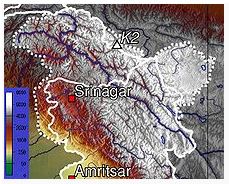
Topographic map of Kasmir.
The eastern region of the former princely state of Kashmir has also been involved in a boundary dispute. In the late 19th- and early 20th centuries, although some boundary agreements were signed between Great Britain, Afghanistan and Russia over the northern borders of Kashmir, China never accepted these agreements, and the official Chinese position did not change with thecommunist takeover in 1949. By the mid-1950s the Chinese army had entered the north-east portion of Ladakh.[37]
“By 1956–57 they had completed a military road through the Aksai Chin area to provide better communication between Xinjiang and western Tibet. India’s belated discovery of this road led to border clashes between the two countries that culminated in the Sino-Indian war of October 1962.”[37]
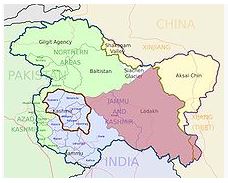
Populous Kashmir valley (Bordered in brown),[38] Jammu and Ladakh are in Indian controlled state of Jammu and Kashmir.
The region is divided among three countries in aterritorial dispute: Pakistan controls the northwest portion (Northern Areas and Azad Kashmir), India controls the central and southern portion (Jammu and Kashmir) and Ladakh, and China controls the northeastern portion (Aksai Chin and the Trans-Karakoram Tract). India controls the majority of theSiachen Glacier area including the Saltoro Ridgepasses, whereas Pakistan controls the lower territory just southwest of the Saltoro Ridge. India controls 101,338 km2 (39,127 sq mi) of the disputed territory, Pakistan 85,846 km2 (33,145 sq mi) and China, the remaining 37,555 km2 (14,500 sq mi).
Jammu and Azad Kashmir lie outside Pir Panjal range, and are under Indian and Pakistani control respectively. These are populous regions. The main cities are Mirpur, Dadayal, Kotli, Bhimber Jammu, Muzaffarabad and Rawalakot.
The Gilgit-Baltistan, formerly called Northern Areas, are a group of territories in the extreme north, bordered by the Karakoram, the westernHimalayas, the Pamir, and the Hindu Kush ranges. With its administrative center at the town of Gilgit, the Northern Areas cover an area of 72,971 km² (28,174 mi²) and have an estimated population approaching 1,000,000. The other main city is Skardu.
Ladakh is a region in the east, between the Kunlun mountain range in the north and the main Great Himalayas to the south.[39] Main cities are Leh and Kargil. It is under Indian administration and is part of the state of Jammu and Kashmir. It is one of the most sparsely populated regions in the area and is mainly inhabited by people of Indo-Aryan and Tibetan descent.[39]
Aksai Chin is a vast high-altitude desert of salt that reaches altitudes up to 5,000 metres (16,000 ft). Geographically part of the Tibetan Plateau, Aksai Chin is referred to as the Soda Plain. The region is almost uninhabited, and has no permanent settlements.
Though these regions are in practice administered by their respective claimants, neither India nor Pakistan has formally recognised the accession of the areas claimed by the other. India claims those areas, including the area “ceded” to China by Pakistan in the Trans-Karakoram Tract in 1963, are a part of its territory, while Pakistan claims the entire region excluding Aksai Chin and Trans-Karakoram Tract. The two countries have fought several declared wars over the territory. The Indo-Pakistani War of 1947 established the rough boundaries of today, with Pakistan holding roughly one-third of Kashmir, and India one-half, with a dividing line of control established by the United Nations. The Indo-Pakistani War of 1965 resulted in a stalemate and a UN-negotiated ceasefire.
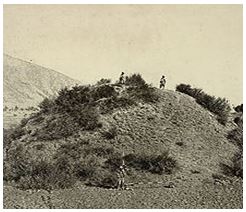
This general view of the unexcavated Buddhist stupa near Baramulla, with two figures standing on the summit, and another at the base with measuring scales, was taken by John Burke in 1868. The stupa, which was later excavated, dates to 500 AD
Kashmir was one of the major centre of Sanskrit scholars. According to the Mahabharata,[3] the Kambojas ruled Kashmir during the epic period with a Republican system of government[4] from the capital city of Karna-Rajapuram-gatva-Kambojah-nirjitastava.,[5][6] shortened to Rajapura,[7][8][9][10] which has been identified with modern Rajauri.[11] Later, the Panchalas are stated to have established their sway. The name Peer Panjal, which is a part of modern Kashmir, is a witness to this fact. Panjal is simply a distorted form of the Sanskritic tribal term Panchala. The Muslims prefixed the word peer to it in memory of Siddha Faqir and the name thereafter is said to have changed into Peer Panjal.[12] The Mauryan emperor Ashoka is often credited with having founded the city of Srinagar.
Kashmir was once a Buddhist seat of learning, perhaps with the Sarvāstivādan school dominating. East and Central Asian Buddhist monks are recorded as having visited the kingdom. In the late 4th century AD, the famous Kuchanese monk Kumārajīva, born to an Indian noble family, studied Dīrghāgama and Madhyāgama in Kashmir under Bandhudatta. He later becoming a prolific translator who helped take Buddhism to China. His mother Jīva is thought to have retired to Kashmir. Vimalākṣa, a Sarvāstivādan Buddhist monk, travelled from Kashmir to Kucha and there instructed Kumārajīva in the Vinayapiṭaka.
Historical Demographics of Kashmir
In the 1901 Census of the British Indian Empire, Muslims constituted 74.16% of the total population of the princely state of Kashmir and Jammu where Gujjar Muslims constitute 20% population, Hindus, 23.72%, and Buddhists, 1.21%. The Hindus were found mainly in Jammu, where they constituted a little less than 70% of the population.[40] In the Kashmir Valley, Muslims constituted 95.6% of the population and Hindus 3.24%.[40] These percentages have remained fairly stable for the last 100 years.[41] Forty years later, in the 1941 Census of British India, Muslims accounted for 93.6% of the population of the Kashmir Valley and the Hindus for 4%.[41] In 2003, the percentage of Muslims in the Kashmir Valley was 95%[42] and those of Hindus 4%; the same year, in Jammu, the percentage of Hindus was 66% and those of Muslims 30%.[42] In the 1901 Census of the British Indian Empire, the population of the princely state of Kashmir and Jammu was 2,905,578. Of these 2,154,695 were Muslims (74.16%), 689,073 Hindus (23.72%), 25,828 Sikhs, and 35,047 Buddhists.
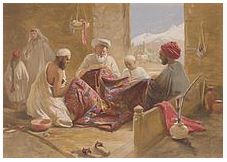
A Muslim shawl making family shown inCashmere shawl manufactory, 1867, chromolith., William Simpson.
Among the Muslims of the princely state, four divisions were recorded: “Shaikhs, Saiyids, Mughals, and Pathans. The Shaikhs, who are by far the most numerous, are the descendants of Hindus, but have retained none of the caste rules of their forefathers. They have clan names known as krams …”[40] It was recorded that these kram names included “Tantre,” “Shaikh,”, “Bhat”, “Mantu,” “Ganai,” “Dar,” “Damar,” “Lon” etc. The Saiyids, it was recorded “could be divided into those who follow the profession of religion and those who have taken to agriculture and other pursuits. Their kram name is “Mir.” While a Saiyid retains his saintly profession Mir is a prefix; if he has taken to agriculture, Mir is an affix to his name.”[40] The Mughals who were not numerous were recorded to have kram names like “Mir” (a corruption of “Mirza”), “Beg,” “Bandi,” “Bach,” and “Ashaye.” Finally, it was recorded that the Pathans “who are more numerous than the Mughals, … are found chiefly in the south-west of the valley, where Pathan colonies have from time to time been founded. The most interesting of these colonies is that of Kuki-Khel Afridis at Dranghaihama, who retain all the old customs and speak Pashtu.”[40] Among the main tribes of Muslims in the princely state are the Butts, Dar, Lone, Jat, Gujjar, Rajput, Sudhan and Khatri. A small number of Butts, Dar and Lone use the title Khawaja and the Khatri use the title Shaikh the Gujjar use the title of Chaudhary. All these tribes are indigenous of the princely state and many Hindus also belong to these tribes.
The Hindus were found mainly in Jammu, where they constituted a little less than 60% of the population.[40] In the Kashmir Valley, the Hindus represented “524 in every 10,000 of the population (i.e. 5.24%), and in the frontier wazarats of Ladhakh and Gilgit only 94 out of every 10,000 persons (0.94%).”[40] In the same Census of 1901, in the Kashmir Valley, the total population was recorded to be 1,157,394, of which the Muslim population was 1,083,766, or 93.6% and the Hindu population 60,641.[40] Among the Hindus of Jammu province, who numbered 626,177 (or 90.87% of the Hindu population of the princely state), the most important castes recorded in the census were “Brahmans(186,000), the Rajputs (167,000), the Khattris (48,000) and the Thakkars (93,000).”[40]
In the 1911 Census of the British Indian Empire, the total population of Kashmir and Jammu had increased to 3,158,126. Of these, 2,398,320 (75.94%) were Muslims, 696,830 (22.06%) Hindus, 31,658 (1%) Sikhs, and 36,512 (1.16%) Buddhists. In the last census of British India in 1941, the total population of Kashmir and Jammu (which as a result of the second world war, was estimated from the 1931 census) was 3,945,000. Of these, the total Muslim population was 2,997,000 (75.97%), the Hindu population was 808,000 (20.48%), and the Sikh 55,000 (1.39%).[43]
The Kashmiri Pandits, the only Hindus of the Kashmir valley, who had stably constituted approximately 4 to 5% of the population of the valley during Dogra rule (1846–1947), and 20% of whom had left the Kashmir valley by 1950,[44] began to leave in much greater numbers in the 1990s. According to a number of authors, approximately 100,000 of the total Kashmiri Pandit population of 140,000 left the valley during that decade.[45] Other authors have suggested a higher figure for the exodus, ranging from the entire population of over 150,000,[46] to 190,000 of a total Pandit population of 200,000,[47] to a number as high as 300,000.[48]


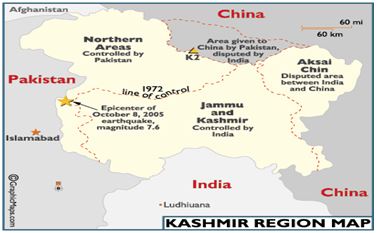
Culture and Cuisine
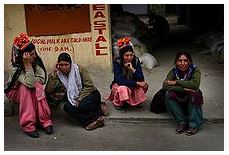
Brokpa women from Kargil, northernLadakh, in local costumes
Kashmiri cuisine includes dum aloo (boiled potatoes with heavy amounts of spice), tzaman (a solid cottage cheese), rogan josh (lamb cooked in heavy spices), yakhiyn (lamb cooked in curd with mild spices), hakh (a spinach-like leaf), rista-gushtaba (minced meat balls in tomato and curd curry),danival korme and of course the signature rice which is particular to Asian cultures. The traditional wazwan feast involves cooking meat or vegetables, usually mutton, in several different ways.
Alcohol is strictly prohibited in most places. There are two styles of making tea in the region: nun chai, or salt tea, which is pink in colour (known as chinen posh rang or peach flower colour) and popular with locals; and kahwah, a tea for festive occasions, made with saffron and spices (cardamom, cinamon,sugar, noon chai leaves), and black tea.
Economy
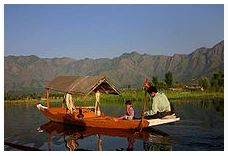
Tourism is one of the main sources of income for vast sections of the Kashmiri population. Shown here is the famous Dal Lake in Srinagar, India.

Skardu in the Northern Areas, is the point of departure for mountaineering expeditions in the Karakorams.
Kashmir’s economy is centred around agriculture. Traditionally the staple crop of the valley was rice, which formed the chief food of the people. In addition, Indian corn, wheat, barley and oats were also grown. Given its temperate climate, it is suited for crops like asparagus, artichoke, seakale, broad beans, scarletrunners, beetroot, cauliflower and cabbage. Fruit trees are common in the valley, and the cultivated orchards yield pears, apples, peaches, and cherries. The chief trees are deodar, firs and pines, chenar or plane, maple, birch and walnut, apple, cherry.
Historically, Kashmir became known worldwide when Cashmere wool was exported to other regions and nations (exports have ceased due to decreased abundance of the cashmere goat and increased competition from China). Kashmiris are well adept at knitting and making Pashminashawls, silk carpets, rugs, kurtas, and pottery. Saffron, too, is grown in Kashmir. Efforts are on to export the naturally grown fruits and vegetables as organic foods mainly to the Middle East. Srinagar is known for its silver-work, papier mache, wood-carving, and the weaving of silk.
The economy was badly damaged by the 2005 Kashmir earthquake which, as of October 8, 2005, resulted in over 70,000 deaths in the Pakistan-controlled part of Kashmir and around 1,500 deaths in Indian controlled Kashmir.
The Indian-administered portion of Kashmir is believed to have potentially rich rocks containing hydrocarbon reserves.[49][50]
History of Tourism in Kashmir
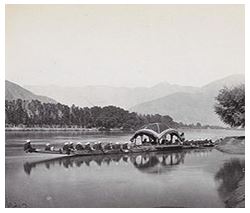
Maharaja’s boat in Munshi Bagh, Srinagar, c. 1860. Photo: Samuel Bourne. The caption states, ‘One of the Maharaja’s boats such as lent to the Comr or Resident on duty & to others, as myself. He has several of these each with 20 rowers.
During the 19th century rule, Kashmir was a popular tourist destination due to its climate. Formerly only 200 passes a year were issued by the government, but now no restriction is placed on visitors. European sportsmen and travellers, in addition to residents of India, traveled there freely. The railway to Rawalpindi, and a road thence to Srinagar made access to the valley easier.
The railway to Rawalpindi, and a road thence to Srinagar made access to the valley easier. When the temperature in Srinagar rose at the beginning of June, the residents migrated to Gulmarg, which was a fashionable hill station during British rule. This great influx of visitors resulted in a corresponding diminution of game for the sportsmen. Special game preservation rules were introduced, and nullahs were let out for stated periods with a restriction on the number of head to be shot. Rawalakot was another popular destination.[citation needed] While tourism in the area fell off with the start of separatist violence in the late 1980s, the BBC reported in 2005 that tourists had begun returning due to a decrease in attacks.[51]
One of the most famous tourist spots in India is the Amarnath cave, which is considered to be one of the holiest shrines in Hinduism. While the cave is regularly visited by pilgrims making offerings, it has been a target for attacks by Islamic militants.


